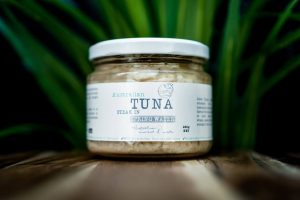Tuna!
Tuna, packed with protein, selenium, vitamin D and amino acids. In fact, all of the essential amino acids needed by our body are found in tuna. Most importantly, tuna is a great source of omega-3 fatty acids. But were you aware of what tuna you should be purchasing to gain the most benefits?
Not all tuna is processed the same way, how the fish is caught, the species of tuna, and the oil it is preserved in all make a considerable difference to the quality of the product. Interestingly, albacore tuna is the only tuna species that is deemed white meat tuna. Compared to the usual pink colour of supermarket canned tunas, the “white meat” tuna has a more subtle, smooth flavour and more of a chunky, meaty texture. Furthermore, Albacore tuna, along with Bluefin tuna, have the highest amount of omega-3 than any other types of the fish, making the species the most favourable addition to our diets.
Why we need Omega-3
You may have heard of omega-3 for its association with joint and brain health, but were you aware that there is no other nutrient more linked to anti-inflammatory benefits than omega-3?
So, what makes its anti-inflammatory abilities so beneficial to our health and bodies?
To answer this, we need to consider the effects of inflammation, most notably, low-grade chronic inflammation.
Ultimately, low-grade chronic inflammation can cause considerable damage to our body and cause many different chronic conditions. Chronic inflammation is basically an ongoing, steady response from our immune system that’s constantly secreting white blood cells, proteins and antibodies to defend our cells. Hence, if this response does not switch off, then it leaves the body with too many white blood cells floating around. Consequently, the white blood cells can start attacking our tissues and organs. Chronic inflammation has been linked to conditions such as cancer, asthma, obesity, type-2 diabetes, and heart disease.
Surprisingly, many of our modern habits can cause inflammation, including alcohol consumption, smoking, a diet high in processed foods and sugars, stress, and pollution.
Other benefits of omega-3 include:
- Supports the nervous system and brain health
- Eye health
- Improves mental conditions such as anxiety and depression
- Reduces the risk of cardiovascular disease
- Reduces inflammation
- Promotes bone and joint health
- Helps to prevent cancer
- Can help prevent autoimmune diseases like type-1 diabetes, Crohn’s disease, and arthritis
What about Selenium?
Tuna is one of the richest sources of the essential micronutrient selenium which is often linked to cardiovascular disease and cancer prevention. Coupled with its biological functions that; assist the immune system response, provide antioxidant defence against free-radicals and cancer cells, and assist thyroid function, it is easy to see the importance of the mineral. Cancer Council Australia states that due to selenium’s protective nature against free radical cell damage, selenium may reduce the risk of certain cancers such as prostate cancer, and is inversely associated with colorectal, lung, and stomach cancer.
Why you should only consume line-caught tuna:
Australian brand Little Tuna is a family owned business that supports a sustainable fishing method which involves line-caught tuna. Did you know that line-caught tuna is considered one of the most sustainable fishing processes? The reason behind this is simple; by avoiding fishing techniques that minimize the amount of bycatch and overfishing. When sustainable fishing practices are not used marine life such as sharks and sea turtles can be killed, along with sea coral, and quality of waters can be damaged.
Oils Used
Another important aspect of selecting the most nutritious tuna to consume is the oil that the tuna is preserved in. Many well-known supermarket brands may state that your tuna is mixed with olive oil, but instead it is a mixture of mainly sunflower oil or other vegetable oils as well. So why should we avoid vegetable oils (such as safflower, grapeseed and sunflower)? In this case, it is due to the high levels of omega-6 fatty acids that they contribute to our diet. High levels of omega-6 in the diet, and lower levels of omega-3 is linked to cardiovascular disease, cancer, and inflammatory and autoimmune diseases. This uneven ratio is linked to the common Western diet, which is more frequently deficient in Omega-3 and rich in Omega-6.
At Nutrition for Life we stock our favourite brand of tuna, Little Tuna, which contains the finest Australian olive oil, and is free of any harmful oils.
CLICK HERE FOR OUR FAMOUS TUNA PATTIE RECIPE

How much omega-3 should we be consuming for optimal health?
Interestingly, there is no recommended dietary intake (RDI) dictated in the Australian and New Zealand Nutrient Reference Values (NRVs) for omega-3’s. Although, the NHS suggests that we consume at least two servings of fish per week, including one serve of oily/fatty fish to gain adequate amounts of omega-3.
Information Sources
Omega 3 and 6 benefits on the nervous system
Thank you for sharing!







